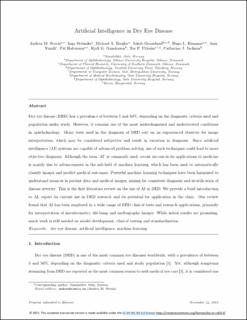| dc.contributor.author | Storås, Andrea Marheim | |
| dc.contributor.author | Strumke, Inga | |
| dc.contributor.author | Riegler, Michael Alexander | |
| dc.contributor.author | Grauslund, Jakob | |
| dc.contributor.author | Hammer, Hugo Lewi | |
| dc.contributor.author | Yazidi, Anis | |
| dc.contributor.author | Halvorsen, Pål | |
| dc.contributor.author | Gundersen, Kjell Gunnar | |
| dc.contributor.author | Utheim, Tor Paaske | |
| dc.contributor.author | Jackson, Catherine Joan | |
| dc.date.accessioned | 2022-02-09T14:29:11Z | |
| dc.date.available | 2022-02-09T14:29:11Z | |
| dc.date.created | 2021-12-02T08:52:37Z | |
| dc.date.issued | 2021-12-01 | |
| dc.identifier.citation | The ocular surface. 2022, 23 74-86. | en_US |
| dc.identifier.issn | 1542-0124 | |
| dc.identifier.uri | https://hdl.handle.net/11250/2978067 | |
| dc.description.abstract | Dry eye disease (DED) has a prevalence of between 5 and 50%, depending on the diagnostic criteria used and population under study. However, it remains one of the most underdiagnosed and undertreated conditions in ophthalmology. Many tests used in the diagnosis of DED rely on an experienced observer for image interpretation, which may be considered subjective and result in variation in diagnosis. Since artificial intelligence (AI) systems are capable of advanced problem solving, use of such techniques could lead to more objective diagnosis. Although the term ‘AI’ is commonly used, recent success in its applications to medicine is mainly due to advancements in the sub-field of machine learning, which has been used to automatically classify images and predict medical outcomes. Powerful machine learning techniques have been harnessed to understand nuances in patient data and medical images, aiming for consistent diagnosis and stratification of disease severity. This is the first literature review on the use of AI in DED. We provide a brief introduction to AI, report its current use in DED research and its potential for application in the clinic. Our review found that AI has been employed in a wide range of DED clinical tests and research applications, primarily for interpretation of interferometry, slit-lamp and meibography images. While initial results are promising, much work is still needed on model development, clinical testing and standardisation. | en_US |
| dc.language.iso | eng | en_US |
| dc.publisher | Elsevier | en_US |
| dc.relation.ispartofseries | The ocular surface;Volume 23, January 2022 | |
| dc.rights | Attribution-NonCommercial-NoDerivatives 4.0 Internasjonal | * |
| dc.rights.uri | http://creativecommons.org/licenses/by-nc-nd/4.0/deed.no | * |
| dc.subject | Dry eye disease | en_US |
| dc.subject | Artificial intelligence | en_US |
| dc.subject | Machine learning | en_US |
| dc.title | Artificial intelligence in dry eye disease | en_US |
| dc.type | Peer reviewed | en_US |
| dc.type | Journal article | en_US |
| dc.description.version | acceptedVersion | en_US |
| cristin.ispublished | true | |
| cristin.fulltext | postprint | |
| cristin.qualitycode | 1 | |
| dc.identifier.doi | https://doi.org/10.1016/j.jtos.2021.11.004 | |
| dc.identifier.cristin | 1963107 | |
| dc.source.journal | The ocular surface | en_US |
| dc.source.volume | 23 | en_US |
| dc.source.pagenumber | 37 | en_US |

